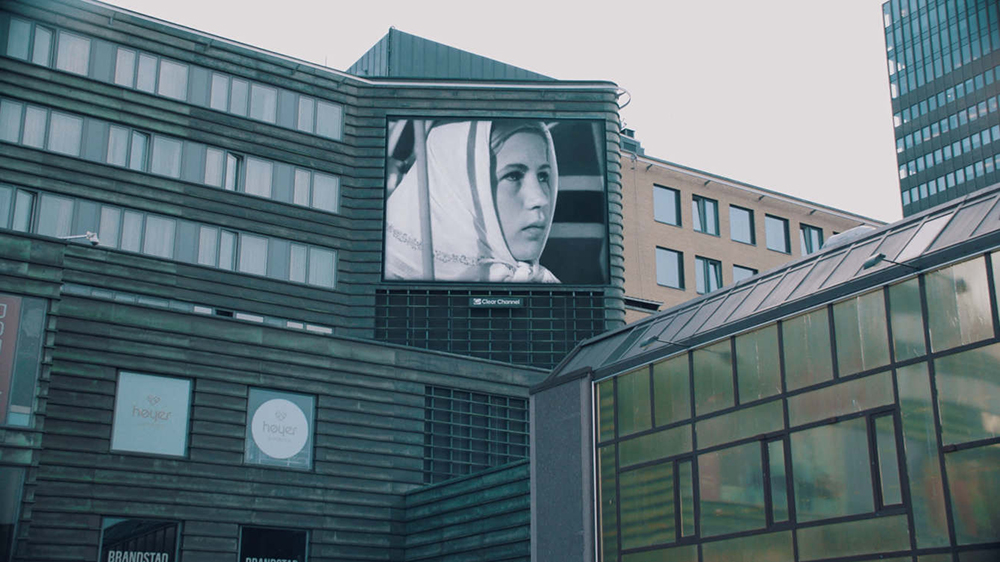
Sara Eliassen, The Feedback Loop, Public screen intervention, Oslo Central Station
and Jernbanetorget, June 11 – 17, 2018
Sara Eliassen’s (b. and b. in Oslo, 1977) site-specific video-intervention for her project The Feedback Loop, which also encompasses a film and conference program and an exhibition at Munchmuseet on The Move – Kunsthall Oslo, Dronning Eufemias gate 34, was displayed in Oslo Central Station for one week in June 2018. To devise the intervention, Eliassen parted from the idea that it was important to break through the daily flow of the images that surround us – the sensible regime – in a dense public space. For the project, screen time from advertisement spaces in Oslo’s Central Station was bought. Some of the screens have the format of giant smartphones, others are more traditional large displays and in them, Eliassen inserted five versions of a (10-) 30 second long video that pop up simultaneously on all screens interrupting the stream of local commercials.
In general, Eliassen explores in her work how our contemporary condition is determined by our existence within the sensible, a regime made up of visibilities and signs that get interwoven through the mass media, cultural production and inter-personal communication. Eliassen is interested in how the sensible regime (or “screen culture”) produces social arrangements, creates subjectivities and organizes gender and class relations and in how more than “reality,” the sensible gives shape to our perception of the world. In the context of the aftermath of Anders Breivik’s 2011 terror attack against Oslo’s civilian population, and the controversy arisen last year by painter Dana Schultz’s alleged appropriation of “black pain,” Eliassen’s The Feedback Loop intervention puts pressing questions on the table about representativity and the rise of Islamophobia, misogyny, class, racism, migration, politics and the crystallization of fascisms across the world with the support of the sensible regime.
For her intervention, Eliassen appropriated and intervened sequences from the Norwegian-German film Symphonie des Nordens: Eine Dichtung in Bild un Ton über Norwegens Landschaft (Symphony of the North: A Poem in Images and Sounds about Norway’s Landscape, 1938), an NS Film production by Julius Sandmeier with music composed by Karl Eisele. Symphonie des Nordens can be said to be made following the political line established by Nazi Propaganda Minister Joseph Gobbels: a sensible regime fabricated with folkloric contours with the goal of displaying the nation’s roots that. The film thus constructs a Norwegian world described through its landscape by glorifying nature, mountains, fjords, forests and folkloric manifestations. For her intervention, Eliassen uses the same montage techniques and morphings as did German propaganda films to induce viewers to identify with nationalist ideology. For her film, she uses the structure of the loop to show first, an open shot of a non-white teenager looking at scenes from Sandmeier’s film in a screen in Oslo’s Central Station; then, we see a shot of the young man’s face at the moment in which his eye absorbs the image of Norway he is seeing. Or maybe the image absorbs him, as we suddenly see him appear inside the images of the snowy Norwegian mountains filmed by Sandmeier. In the end, the screen material, the screen itself and the human all merge.
With her intervention in Oslo’s Central Station, Eliassen provocatively poses an image-question: does our contemporary sensible regime function as a form of propaganda and how? Clearly not by constructing national identities, but through more insidious ways of producing desirable and non-desirable subjectivities, surreptitiously pushing for new versions of “us” and “others” based on ethnic roots, as opposed to national belonging (based on a link between race and land). By making resurface the ghostly images of national identities that supported fascisms in the first half of the 20th Century, as the background of the image of an immigrant teenager in contemporary Norway absorbing or being absorbed by those images, Eliassen interrogates how the models of Anglosaxon multiculturalism or French integrationism could work in post-Breivik Norway (as they have obviously failed). In fascisms of the first half of the 20th Century, ethnicity was race was nation linked to territory (the Nazi logic of “Blut und Boden”). Today, ethnicity is difference and singularity, linked to transnational communities (as opposed to territory) and inseparable from a political demand for visibility and recognition. In a way, ethnicity (and religion and sexuality) is to globalization what ideology was to the Cold War. Instead of a singular mass dancing in an anonymous movement under the baton of a dictator, now fragments of masses dance to express rejection to be directed by the movements of a single baton, and are against being molded by a single national identity. As the question of class difference has been superseded by the racialized economic distribution of wealth and privilege across the planet, what does recognition mean when unilateral dominion relations prevail? A new, pluralized version of the “Volk” has returned stupidly and bloodily spreading an obsession with belonging and aggressive identitarian affirmation. This results from the general prevailing of a sense of displacement and the loss of tradition and emotional roots, leading to aggressive and destructive forms of reterritorialization by returning to the past in the shape of aggressive singularized ethnic, religious and sexual identities.
Irmgard Emmelhainz